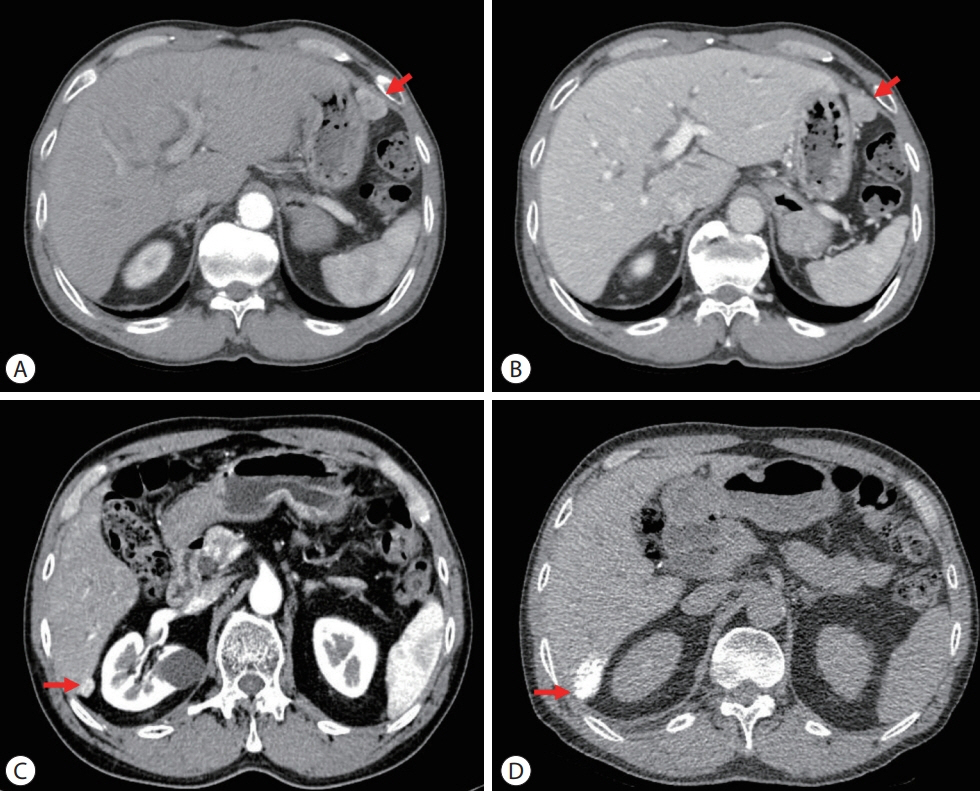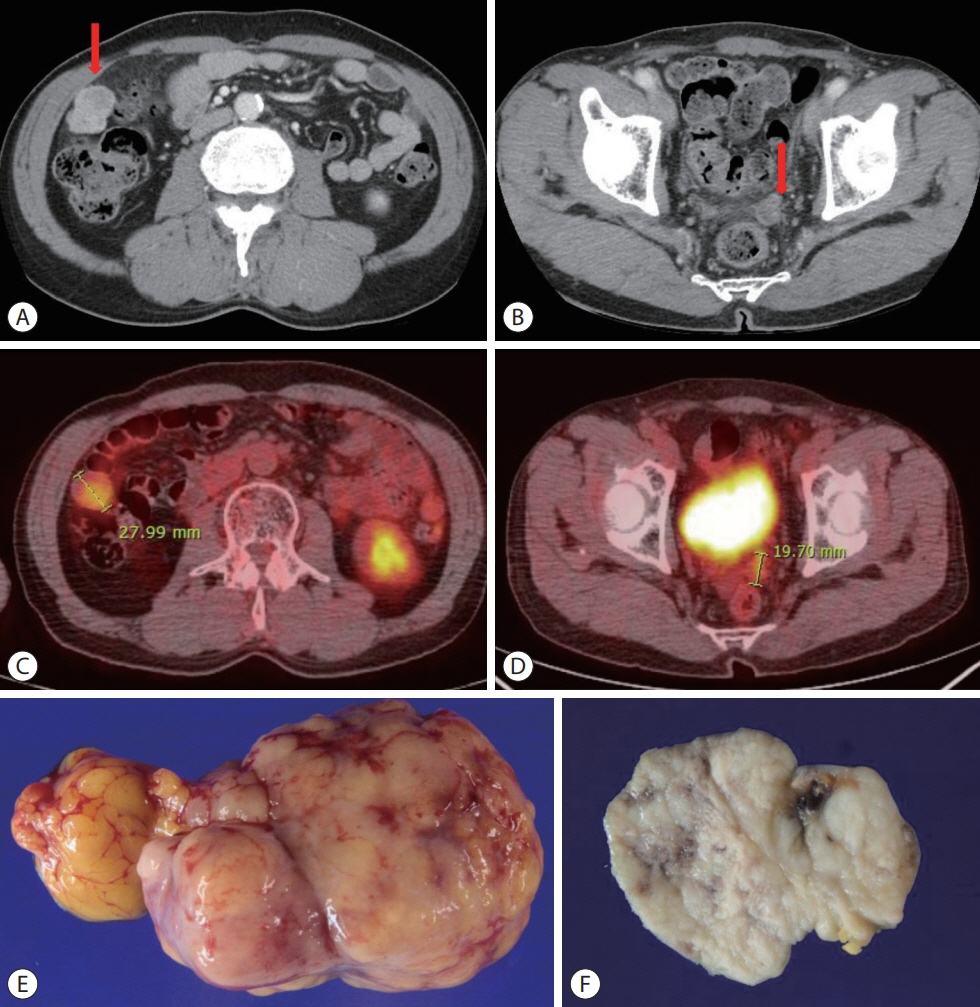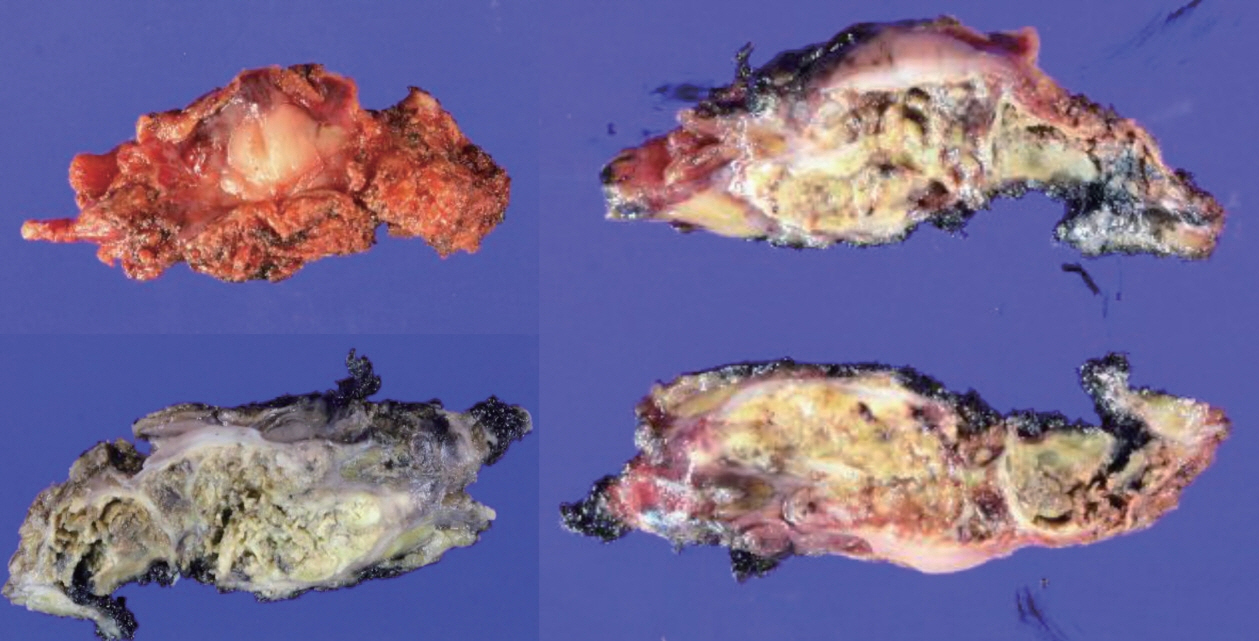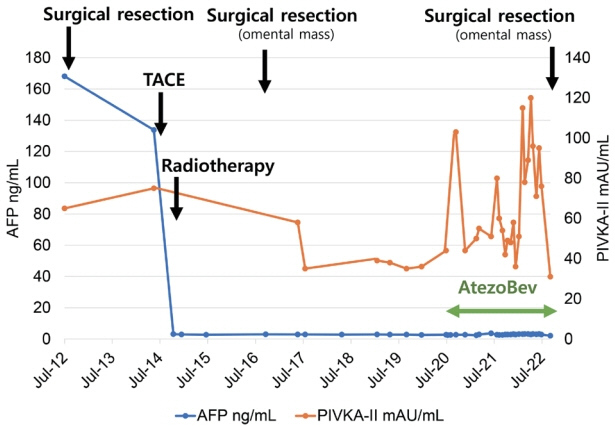J Liver Cancer.
2023 Mar;23(1):206-212. 10.17998/jlc.2023.02.09.
A case of successful surgical treatment for peritoneal seeding of hepatocellular carcinoma after radiotherapy and atezolizumab plus bevacizumab combination treatment
- Affiliations
-
- 1Center for Liver and Pancreatobiliary Cancer, National Cancer Center, Goyang, Korea
- 2Graduate School of Cancer Science and Policy, National Cancer Center, Goyang, Korea
- 3Proton Therapy Center, National Cancer Center, Goyang, Korea
- 4Department of Radiology, National Cancer Center Research Institute, Goyang, Korea
- KMID: 2540833
- DOI: http://doi.org/10.17998/jlc.2023.02.09
Abstract
- Peritoneal seeding of hepatocellular carcinoma (HCC) is incurable and has poor prognosis. A 68-year-old man underwent surgical resection for a 3.5 cm single nodular HCC at the tip of segment 3 and transarterial chemoembolization for a 1.5 cm-sized recurrent HCC at the tip of segment 6. 3 months later, an increasing 1 cm pelvic nodule on the rectovesical pouch warranted radiotherapy. Although it stabilized, a new 2.7 cm-sized peritoneal nodule in the right upper quadrant (RUQ) omentum appeared 3.5 years after radiotherapy. Hence, omental mass and small bowel mesentery mass excision were performed. 3 years later, recurrent peritoneal metastases in the RUQ omentum and rectovesical pouch progressed. 33 cycles of atezolizumab and bevacizumab treatment elicited stable disease response. Finally, laparoscopic left pelvic peritonectomy was performed without tumor recurrence. Herein, we present a case of HCC with peritoneal seeding that was successfully treated with surgery after radiotherapy and systemic therapy, leading to complete remission.
Figure
Reference
-
References
1. Hung MC, Wu HS, Lee YT, Hsu CH, Chou DA, Huang MH. Intraperitoneal metastasis of hepatocellular carcinoma after spontaneous rupture: a case report. World J Gastroenterol. 2008; 14:3927–3931.
Article2. Lee SK, Song MJ. Drop metastasis from hepatocellular carcinoma after percutaneous radiofrequency ablation therapy. Korean J Intern Med. 2017; 32:943–944.
Article3. Korean Liver Cancer Association; National Cancer Center. 2022 KLCA-NCC Korea practice guidelines for the management of hepatocellular carcinoma. Clin Mol Hepatol. 2022; 28:583–705.4. Portolani N, Baiocchi GL, Gheza F, Molfino S, Lomiento D, Giulini SM. Parietal and peritoneal localizations of hepatocellular carcinoma: is there a place for a curative surgery? World J Surg Oncol. 2014; 12:298.
Article5. Nakayama H, Takayama T, Makuuchi M, Yamasaki S, Kosuge T, Shimada K, et al. Resection of peritoneal metastases from hepatocellular carcinoma. Hepatogastroenterology. 1999; 46:1049–1052.6. Kirikoshi H, Saito S, Yoneda M, Fujita K, Mawatari H, Uchiyama T, et al. Outcomes and factors influencing survival in cirrhotic cases with spontaneous rupture of hepatocellular carcinoma: a multicenter study. BMC Gastroenterol. 2009; 9:29.
Article7. Sonoda T, Kanematsu T, Takenaka K, Sugimachi K. Ruptured hepatocellular carcinoma evokes risk of implanted metastases. J Surg Oncol. 1989; 41:183–186.
Article8. Yeh CN, Chen MF. Resection of peritoneal implantation of hepatocellular carcinoma after hepatic resection: risk factors and prognostic analysis. World J Surg. 2004; 28:382–386.
Article9. Lin CC, Liang HP, Lee HS, Huang GT, Yang PM, Ho MC, et al. Clinical manifestations and survival of hepatocellular carcinoma patients with peritoneal metastasis. J Gastroenterol Hepatol. 2009; 24:815–820.
Article10. Belluco C, Petricoin EF, Mammano E, Facchiano F, Ross-Rucker S, Nitti D, et al. Serum proteomic analysis identifies a highly sensitive and specific discriminatory pattern in stage 1 breast cancer. Ann Surg Oncol. 2007; 14:2470–2476.
Article11. Kudo M, Kitano M, Sakurai T, Nishida N. General rules for the clinical and pathological study of primary liver cancer, nationwide follow-up survey and clinical practice guidelines: the outstanding achievements of the Liver Cancer Study Group of Japan. Dig Dis. 2015; 33:765–770.
Article12. Hai S, Okada T, Iimuro Y, Hirano T, Suzumura K, Fujimoto J. Successful laparoscopic extirpation of peritoneal dissemination after hepatectomy for ruptured hepatocellular carcinoma. Asian J Endosc Surg. 2015; 8:465–467.
Article13. Kurachi K, Suzuki S, Yokoi Y, Okumura T, Inaba K, Igarashi T, et al. A 5-year survivor after resection of peritoneal metastases from pedunculated-type hepatocellular carcinoma. J Gastroenterol. 2002; 37:571–574.
Article14. Lin CC, Chen CH, Tsang YM, Jan IS, Sheu JC. Diffuse intraperitoneal metastasis after spontaneous rupture of hepatocellular carcinoma. J Formos Med Assoc. 2006; 105:577–582.
Article15. Kim SR, Ikawa H, Ando K, Mita K, Fuki S, Imoto S, et al. Small hepatocellular carcinoma presenting with massive metastasis in the peritoneum, mimicking sarcomatous tumor. Hepatol Res. 2007; 37:885–889.
Article16. Yeh CN, Chen MF, Jeng LB. Resection of peritoneal implantation from hepatocellular carcinoma. Ann Surg Oncol. 2002; 9:863–868.
Article17. Walkey MM, Friedman AC, Sohotra P, Radecki PD. CT manifestations of peritoneal carcinomatosis. AJR Am J Roentgenol. 1988; 150:1035–1041.
Article18. Da Fonseca LG, Leonardi PC, Hashizume PH, Sansone F, Saud LR, Carrilho FJ, et al. A multidisciplinary approach to peritoneal metastasis from hepatocellular carcinoma: clinical features, management and outcomes. Clin Exp Hepatol. 2022; 8:42–48.
Article19. Enomoto H, Fujiwara M, Kono H, Kako Y, Takahagi M, Taniguchi J, et al. Metastasis of hepatocellular carcinoma in the pouch of Douglas successfully treated by radiation therapy: a case report. Life (Basel). 2023; 13:225.
Article20. Katsura Y, Takeda Y, Ohmura Y, Sakamoto T, Shinke G, Katsuyama S, et al. A case of successful treatment of recurrent peritoneal dissemination of hepatocellular carcinoma with atezolizumab plus bevacizumab combination therapy. Gan To Kagaku Ryoho. 2021; 48:2027–2029.
- Full Text Links
- Actions
-
Cited
- CITED
-
- Close
- Share
- Similar articles
-
- Atezolizumab and bevacizumab for hepatocellular carcinoma: How to approach salvage therapy for non-responders?: Editorial on “Sorafenib vs. Lenvatinib in advanced hepatocellular carcinoma after atezolizumab/bevacizumab failure: A real-world study”
- Concurrent transarterial radioembolization and combination atezolizumab/ bevacizumab treatment of infiltrative hepatocellular carcinoma with portal vein tumor thrombosis: a case report
- Favorable response of hepatocellular carcinoma with portal vein tumor thrombosis after radiotherapy combined with atezolizumab plus bevacizumab
- A Case of Transverse Myelitis Following Treatment with Atezolizumab for Advanced Hepatocellular Carcinoma
- Complete response in hepatocellular carcinoma with lymph node metastasis by combination therapy of atezolizumab and bevacizumab: a case report







